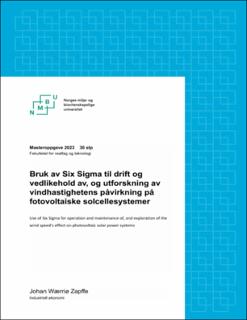| dc.contributor.advisor | Jesper Frausig | |
| dc.contributor.advisor | Ingunn Burud | |
| dc.contributor.author | Zapffe, Johan Wærriø | |
| dc.date.accessioned | 2023-11-30T17:27:12Z | |
| dc.date.available | 2023-11-30T17:27:12Z | |
| dc.date.issued | 2023 | |
| dc.identifier | no.nmbu:wiseflow:6839553:54592043 | |
| dc.identifier.uri | https://hdl.handle.net/11250/3105494 | |
| dc.description.abstract | For å unngå alvorlige konsekvenser av klimaendringene, er det nødvendig å innføre store mengder utslippsfri strømproduksjon. En av teknologiene med størst potensial for dette, er fotovoltaiske solceller, som blir installert i store mengder i hele verden. Ifølge NVE (udatert-b), ble over halvparten. av solcellene i Norge installert i 2022, og det forventes at Norge vil ha en strømproduksjon fra solceller på 6 TWh i 2040 (Birkelund mfl., 2021). For å minimere teknologiens livstidsutslipp, er det nødvendig å drifte og vedlikeholde solcellesystemer effektivt. Formålet med denne oppgaven er derfor å teste Six Sigma som metode, og spesifikt DMAIC-metodologien, for drift og vedlikehold av solcellesystemer.
For å utforske om DMAIC kan brukes til drift og vedlikehold av solcelleanlegg, ble det hentet inn datasett fra tre solcelleparker. To parker i Norge og Sverige – forskningsanlegg ved Norges miljø- og biovitenskapelige universitet og Glava Energy Center (GEC) – som eksempler på det nordiske klimaet, og en park i Australia – Desert Knowledge Australia Solar Centre (DKASC) – som referanse. Som del av dette, ble det laget en modell av parkene i pvlib python. Grunnet en misforståelse, ble ikke datasettet fra GEC benyttet.
Resultatene viser at DMAIC-metodologien egner seg til å lage en forventning til produksjon, og at modellering er et godt verktøy for dette. Det ble under analysen avdekket flere avvik fra forventningene, hvilket indikerte at deler av solcellesystemene ikke produserte strøm på samme nivå som de skulle. Dette kan implementeres i sanntid for å forhindre at feil ikke oppdages i tide og blir uopprettelige, samt til å forbedre oppetid.
En lineær regresjonsanalyse fant en sammenheng mellom vindhastigheten og modellens avvik fra målte verdier på −6,11W og 3,90W per sekundmeter økte vindhastighet ved henholdsvis Søråsjordet og DKASC. Mellom vindhastigheten og produserte effekter, var sammenhengen på −4,44W og 28,34W. Det konkluderes derfor med at vindhastigheten ikke har stor påvirkning av verken modellens treffsikkerhet eller totalt effektutbytte. | |
| dc.description.abstract | To avoid severe impacts from climate change, it is necessary to introduce large amounts of emissions-free power production. One of the technologies with the greatest potential for achieving this is photovoltaic (PV) solar cells, which has led to a rapid increase in installations. According to NVE (n.d.-b), more than half of the solar cells in Norway were installed in 2022, and it is expected that solar power production in Norway will grow to 6 TWh in 2040 (Birkelund et al., 2021). To minimise the total environmental impacts of PV systems, it is necessary to operate and maintain such systems efficiently. Therefore, the purpose of this thesis is to test Six Sigma as a method, in particular the DMAIC methodology, for the operation and maintenance of solar cell systems.
To test the ability of DMAIC to improve the operation and maintenance of PV systems, data sets were collected from three PV solar parks. Two parks in Norway and Sweden — research facilities at the Norwegian University of Life Sciences and Glava Energy Center (GEC) — were used as examples of solar parks in the Nordic climate, and one park in Australia — Desert Knowledge Australia Solar Centre (DKASC) — was used as a reference. To establish a norm, a model of the systems was created in pvlib python. Due to a misunderstanding, the data set from GEC was not used.
The DMAIC methodology was found to be suitable for creating an expected production, and that modelling was a useful tool in this process. Several deviations from the expectation were uncovered during the analysis, indicating that parts of the solar cell systems were not producing electricity at the level they should. This can be implemented in real-time to prevent errors from going undetected and becoming irreparable, as well as increasing system uptime.
A linear regression analysis found a relationship between wind speed and the model’s deviations from the measured values of −6.11W and 3.90W per 1 m/s increase of wind speed at Søråsjordet and DKASC, respectively. A second linear regression for wind speed and produced power found a relationship of −4.44W and 28.34W. Therefore, it is concluded that wind speed does not have a significant impact on the reliability of the model nor on total power output. | |
| dc.language | nob | |
| dc.publisher | Norwegian University of Life Sciences | |
| dc.title | Bruk av Six Sigma til drift og vedlikehold av, og utforskning av vindhastighetens påvirkning på fotovoltaiske solcellesystemer | |
| dc.type | Master thesis | |
